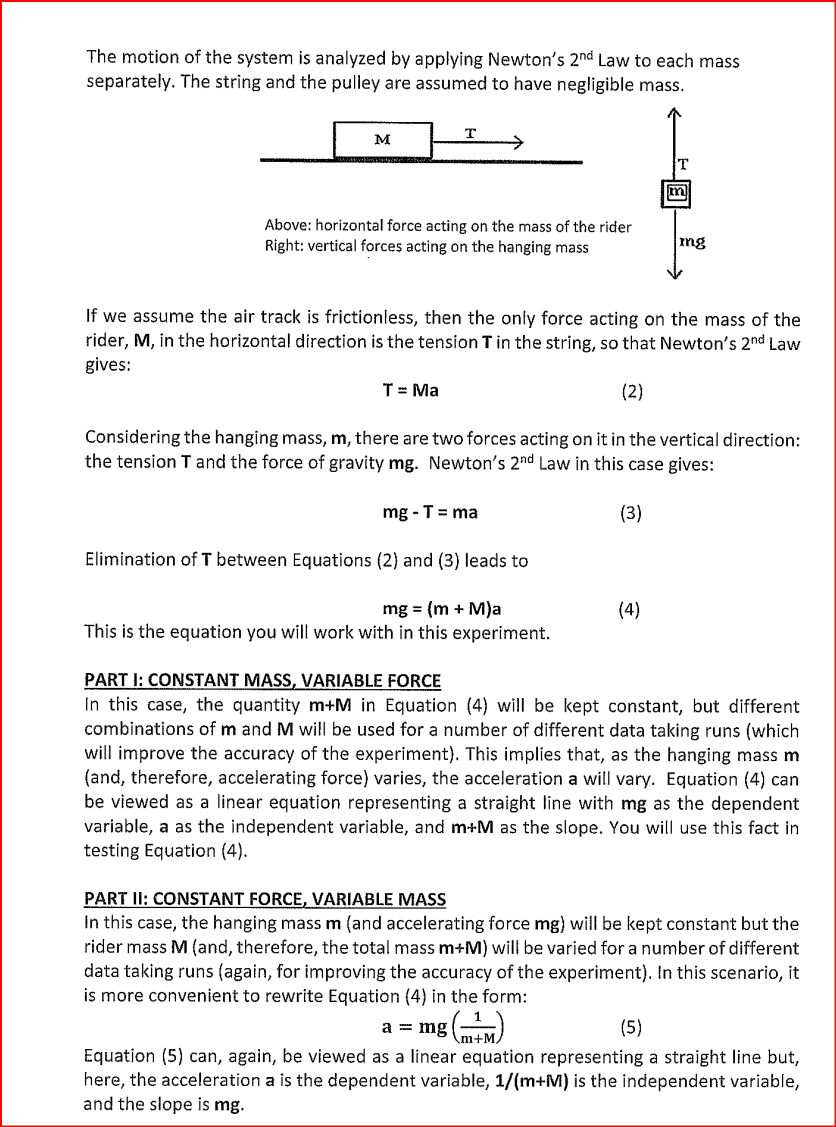University Physics Volume 1
18th Edition
ISBN:9781938168277
Author:William Moebs, Samuel J. Ling, Jeff Sanny
Publisher:William Moebs, Samuel J. Ling, Jeff Sanny
Chapter5: Newton's Law Of Motion
Section: Chapter Questions
Problem 23P: While sliding a couch across a floor, Andrea and Jennifer exert forces FA and FJ on the couch....
Related questions
Question
What is the “theoretical slope” for “part 1 case” and "part 2 case"?

Transcribed Image Text:The motion of the system is analyzed by applying Newton's 2nd Law to each mass
separately. The string and the pulley are assumed to have negligible mass.
M
Above: horizontal force acting on the mass of the rider
Right: vertical forces acting on the hanging mass
T-Ma
If we assume the air track is frictionless, then the only force acting on the mass of the
rider, M, in the horizontal direction is the tension T in the string, so that Newton's 2nd Law
gives:
mg - T = ma
m
(2)
Considering the hanging mass, m, there are two forces acting on it in the vertical direction:
the tension T and the force of gravity mg. Newton's 2nd Law in this case gives:
(3)
Elimination of T between Equations (2) and (3) leads to
mg = (m + M)a
This is the equation you will work with in this experiment.
Ing
(4)
PART I: CONSTANT MASS, VARIABLE FORCE
In this case, the quantity m+M in Equation (4) will be kept constant, but different
combinations of m and M will be used for a number of different data taking runs (which
will improve the accuracy of the experiment). This implies that, as the hanging mass m
(and, therefore, accelerating force) varies, the acceleration a will vary. Equation (4) can
be viewed as a linear equation representing a straight line with mg as the dependent
variable, a as the independent variable, and m+M as the slope. You will use this fact in
testing Equation (4).
PART II: CONSTANT FORCE, VARIABLE MASS
In this case, the hanging mass m (and accelerating force mg) will be kept constant but the
rider mass M (and, therefore, the total mass m+M) will be varied for a number of different
data taking runs (again, for improving the accuracy of the experiment). In this scenario, it
is more convenient to rewrite Equation (4) in the form:
a = mg (¹M)
m+M/
(5)
Equation (5) can, again, be viewed as a linear equation representing a straight line but,
here, the acceleration a is the dependent variable, 1/(m+M) is the independent variable,
and the slope is mg.
Expert Solution
This question has been solved!
Explore an expertly crafted, step-by-step solution for a thorough understanding of key concepts.
This is a popular solution!
Trending now
This is a popular solution!
Step by step
Solved in 2 steps

Knowledge Booster
Learn more about
Need a deep-dive on the concept behind this application? Look no further. Learn more about this topic, physics and related others by exploring similar questions and additional content below.Recommended textbooks for you

University Physics Volume 1
Physics
ISBN:
9781938168277
Author:
William Moebs, Samuel J. Ling, Jeff Sanny
Publisher:
OpenStax - Rice University

Glencoe Physics: Principles and Problems, Student…
Physics
ISBN:
9780078807213
Author:
Paul W. Zitzewitz
Publisher:
Glencoe/McGraw-Hill

Principles of Physics: A Calculus-Based Text
Physics
ISBN:
9781133104261
Author:
Raymond A. Serway, John W. Jewett
Publisher:
Cengage Learning

University Physics Volume 1
Physics
ISBN:
9781938168277
Author:
William Moebs, Samuel J. Ling, Jeff Sanny
Publisher:
OpenStax - Rice University

Glencoe Physics: Principles and Problems, Student…
Physics
ISBN:
9780078807213
Author:
Paul W. Zitzewitz
Publisher:
Glencoe/McGraw-Hill

Principles of Physics: A Calculus-Based Text
Physics
ISBN:
9781133104261
Author:
Raymond A. Serway, John W. Jewett
Publisher:
Cengage Learning

Classical Dynamics of Particles and Systems
Physics
ISBN:
9780534408961
Author:
Stephen T. Thornton, Jerry B. Marion
Publisher:
Cengage Learning